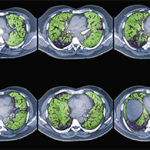Dr. Griffith treats patients with scleroderma-related ILD with mycophenolate mofetil, tocilizumab and cyclophosphamide. Other treatment options include azathioprine and rituximab. She said nintedanib, an antifibrotic medication, was recently approved for the treatment of chronic, fibrosing ILD, with a progressive phenotype, and another antifibrotic, pirfenidone, is currently in clinical trials.
Dr. Griffith also emphasized that it’s important to treat gastroesophageal reflux disease in this patient population. She recommended proton pump inhibitors and histamine H2-blockers, as well as elevating the head of the bed and modifying a patient’s diet to avoid trigger foods and avoid late meals. Some patients, she said, may also benefit from esophagogastroduodenoscopy with esophageal dilation.
Approximately half of patients with scleroderma will eventually be diagnosed with ILD, but the risk for ILD varies by the type of scleroderma.
RA-Associated ILD
Dr. Griffith asks her patients with rheumatoid arthritis (RA) about respiratory symptoms at every visit. She also carefully examines patients with RA for pulmonary rales. If patients have symptoms or pulmonary function test progression, she orders a high-resolution CT scan. For patients with significant lung disease, she performs pulmonary function tests every three to six months.
MDA5 Dermatomyositis & ILD
“MDA5 is a bad actor for [ILD],” said Dr. Griffith, adding, “These patients are at high risk from dying from their lung disease.”
She emphasized that young patients with rapidly progressive ILD and rashes should be evaluated for myositis, with the recognition that their autoantibody profile can be important for prognosis.
Dr. Griffith often treats these patients with glucocorticoids and cyclosporine A or tacrolimus. “This is a really heavy regimen, but it is sometimes necessary, considering how sick these patients get,” she said.
Interstitial Pneumonia with Autoimmune Features
Patients with interstitial pneumonia have some features of autoimmunity, but do not have a characterizable CTD. Dr. Griffith looks for key features of autoimmunity in these patients and considers a biopsy if these features are unclear. She relies heavily on the expertise of pathologists and radiologists, and if she feels a patient has the features of interstitial pneumonia with autoimmunity, she prescribes immunosuppression.
Lara C. Pullen, PhD, is a medical writer based in the Chicago area.
References
- Fischer A, du Bois R. Interstitial lung disease in connective tissue disorders. Lancet. 2012 Aug 18;380(9842):689–698.
- Mueller-Mang C, Grosse C, Schmid K, et al. What every radiologist should know about idiopathic interstitial pneumonias. Radiographics. 2007 May–Jun;27(3):595–615.
- Castelino FV, Goldberg H, Dellaripa PF. The impact of rheumatological evaluation in the management of patients with interstitial lung disease. Rheumatology (Oxford). 2011 Mar;50(3):489–493.
- Idiopathic Pulmonary Fibrosis Clinical Research Network. Prednisone, azathioprine, and N-acetylcysteine for pulmonary fibrosis. N Engl J Med. 2012 May 24;366(21):1968–1977.

